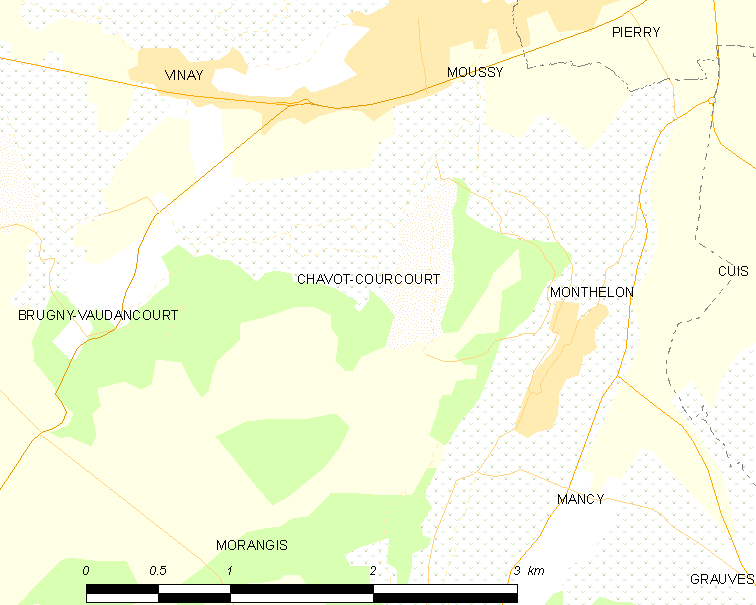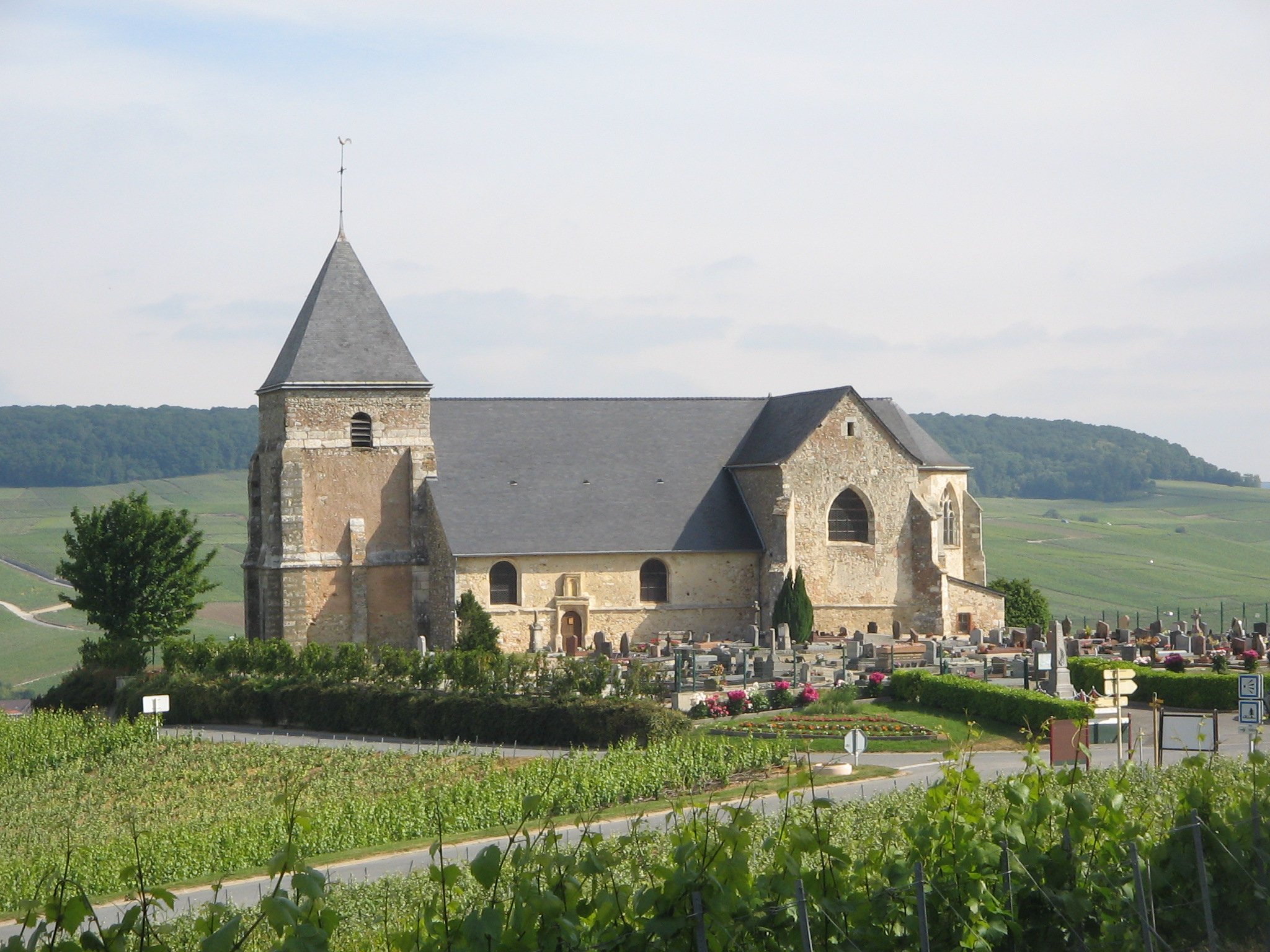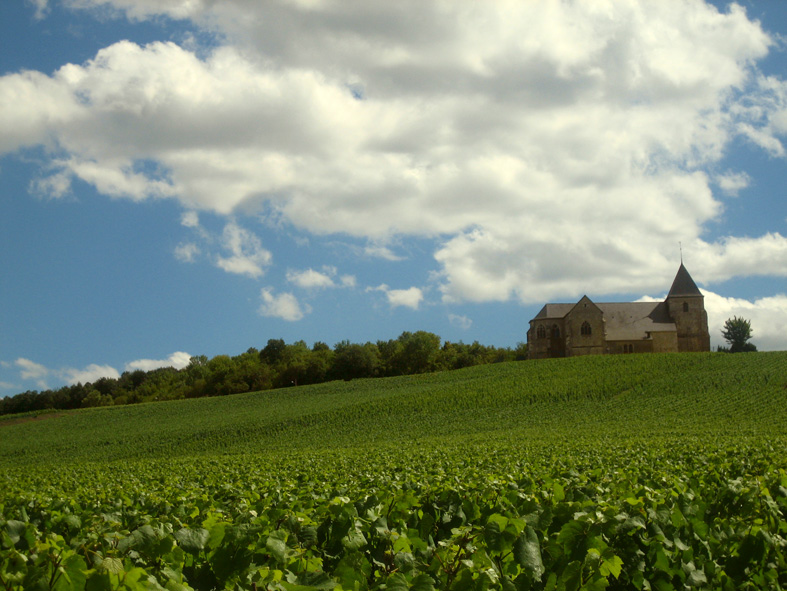 Key facts
Key facts
Located in subregion / area: Vallée de la Marne / Côteaux Sud d’Épernay
Vineyards and grape varieties: 125.6 hectares (310.4 acres), of which 51% Pinot Meunier, 44% Chardonnay, and 5% Pinot Noir.
Classification: “Autre cru” (88%)
Maps

The map is linked from Wikimedia Commons, and the geographical information originates from OpenStreetMap. The dotted white area corresponds to the vineyards, light yellow is other open terrain, orange is built-up areas, and green indicates forest.
Google Maps view with all the villages in the Côteaux Sud d’Épernay area highlighted. The premier cru village of the area, Pierry, is in yellow and the other villages, including Chavot-Courcourt, are shown in orange.
Clicking on a village opens a field to the left with a link to the village profile.
Neighbouring villages
North: Moussy
East: Monthelon
South: Morangis
West: Brugny-Vaudancourt
Northwest: Vinay

The church in Chavot, Église Saint-Martin, surrounded by vineyards. The vineyards in the background are situated in the slopes above Moussy and Pierry. Picture linked from Wikimedia Commons (photo Meneerke bloem, 2011).
The village
Chavot-Courcourt is located to the southwest of Épernay, on the southern side of the valley formed by the stream Le Cubry.
The Chavot-Courcourt commune consists of the two villages Chavot (in the northeastern part of the commune) and Courcourt (in the central part of the commune), but also the small villages Ferme du Jard, Les Fleuries, La Grange au Bois, and Le Pont de Bois. In older times, Chavot was spelled Chavost.
The Chavot-Courcourt commune covers 442 hectares and has 362 inhabitants (as of 2013).
Vineyards
The vineyards in Chavot-Courcourt is located in the northern part of the commune, around Chavot och Courcourt, on slopes that are part of the valley formed by the stream Le Cubry. The vineyards are located on the right bank of Le Cubry (the south side), and consist of slopes with directions from west via north to east, but where north- to northeast-facing slopes dominate. The vineyards are continuous with those in Brugny-Vaudancourt and Monthelon. Pinot Meunier is the dominating grape variety.
The current vineyard surface in the Chavot-Courcourt commune is 125.6 hectares (310.4 acres). There are 64.3 ha Pinot Meunier (51.2%), 54.9 ha Chardonnay (43.7%), and 6.4 ha Pinot Noir (5.1%). Numbers from CIVC, as of 2013. In 1997, the vineyard surface was 124 ha. There are 80 vineyard owners (exploitants) in the commune.
Champagne houses that control vineyards in the village include Taittinger.
Single vineyard sites
- Les Beaudiers, a vineyard in Chavot where Laherte Frères has old vines of Pinot Meunier (planted in 1953, 1958, and 1965) that are used for a Rosé Saignée.
Other vineyard sites in Chavot-Courcourt include Les Charmées, Les Chemins d’Epernay, Les Monts Bougies, Les Noelles, La Potote, and Les Rouges Maison, all used by Laherte Frères for their Champagnes Les Vignes d’Autrefois and Les Empreintes.

The church in Chavot, Église Saint-Martin, surrounded by vineyards. Picture linked from Wikimedia Commons (photo Meena Kadri, 2007, originally uploaded to Flickr).
Champagne producers
Champagne houses/négociants
The producer status NM = négociant-manipulant means that purchased grapes can be included in the Champagnes. NM producers can be anything from small producers that supplement their own grapes with some that they buy in, to large Champagne houses that primarily rely on purchased grapes.
- Lavaure-Huber (NM), a producer created in 1999 by the couple Patrick Lavaure and Isabelle Huber (granddaughter of Diogène Tissier, see below); the name has has been used in 2006.
- Laherte Frères (NM), a small Champagne house that is counted as one among the new generation of small growers. Has slightly more than 10.5 ha of vineyards distributed over ten villages in three areas: Côteaux Sud d’Épernay (Chavot, Épernay, Vaudancourt, Moussy, Mancy, and Morangis), Côte des Blancs (Vertus and Voipreux), and the Vallée de la Marne Rive Gauche (Le Breuil and Boursault). They are négociants (NM) since the vineyards are owned by the different relatives; they don’t buy in any “foreign” grapes. Part of the vineyard holdings are farmed biodynamically and oak barrels are used for a large part of their range. The upper part of the range include Les Vignes d’Autrefois on old vines Pinot Meunier planted in 1947-1953 (in Chavot and Mancy), the vineyard-designated Rosée de Saignée Les Beaudiers from old vines Pinot Meunier (in Chavot), Les Empreintes which is a cuvée from good vineyards in Chavot (the blend varies, usually Chardonnay and Pinot Noir, and sometimes Pinot Meunier), and Les 7 (formerly called Les Clos) which contains all seven allowed Champagne grapes, including the four unusual ones (Fromenteau/Pinot Gris, Arbanne, Pinot Blanc, and Petit Meslier), the first release in 2009 and the grapes originate from rather new plantings in Chavot that yielded their first harvest in 2005.
- Diogène Tissier & Fils (NM), a Champagne house that has just under 9 ha of vineyards, mostly in Chavot-Courcourt, but also Épernay, Barbonne-Fayel, La Celle-sous-Chantemerle, Vitry-en-Perthois, and Chervey. Partly uses small oak barrels for the vineyards. The annual production is about 120 000 bottles.
History
The producer was founded in 1931 by Diogène Tissier. Today run by a grandchild of Diogène, Vincent Huber. Some of the other producers in the village are also run by Diogène Tissier’s offspring.
The Champagnes are also sold under the brand:- Bernard Tissier (website not active in July 2015)
Champagne growers
Producer status is indicated where known: RM = récoltant-manipulant, or grower-producers. RC = récoltant-coopérateur, growers that are cooperative members but sell Champagnes under their own name. Smaller producers are placed under this heading when no information regarding producer status is available.
- Patrick Barré (RC) has 5.95 ha of vineyards.
History
The producer was founded in 1960 by Henri Barré and his son Marcel Barré. Marcel’s son Patrick took over in 1989. - Philippe Daviaux
- Roger Desbordes & Fils (RM), has 8 ha of vineyards.
- Eric Lagache (RC), their vintage Champagne consists of a majority of Chardonnay.
- Lagache-Lecourt (RC), with two vintage Champagnes in their range, Cuvée Chambecy with a majority of Chardonnay, and Cuvée Mariandine, which is completely vinified in oak.
- Laroche Michel, not to be confused with Michel Laroche in Vauciennes.
- Lebeau-Batiste (RC), their vintage Chanpagne consists of a majority of Chardonnay.
- Lucien Leblond (RM), has 9 ha of vineyards in the Côteaux Sud d’Épernay. The vintage Champagne consists of a majority of Chardonnay.
- Lequien et Fils (RM), has 4 ha of vineyards in Chavot-Courcourt, Verneuil, Vincelles, and Chavenay (in Dormans), the three last ones in the Vallée de la Marne.
- Pothelet-Margouillat
- Selosse-Laherte
- Selosse-Pajon (RM), has 6 ha of vineyards in the Vallée de la Marne, Côteaux Sud d’Épernay, and Côte des Blancs (including Avize), with 49% Chardonnay, 30% Pinot Meunier, and 21% Pinot Noir. The range includes a Blanc de Blancs Grand Cru à Avize (non-vintage) and a vintage Champagne with a majority of Chardonnay that is partly oaked.
- André Tissier & Fils (RC), has vineyards with 50% Pinot Meunier, 40% Chardonnay, and 10% Pinot Noir. Their vintage Champagne consists of a majority of Chardonnay.
History
André Tissier, son of Diogène Tissier (see above), started to sell his own Champagnes from 1963, but formed the company in 1985 together with the son Hervé (1963-). - J. M. Tissier (RM), has 5 ha of vineyards in Chavot-Courcourt, Moussy, Pierry, and in the Sézannais area. The vintage Champagne is called Apollon.
History
Has a background in the Champagne house of Diogène Tissier (see above) founded in 1931. The producer is today run by his grandson Jacques Tissier, who in 1998 took this name for the house, after his father Jean-Marie Tissier (-2012). - Jérôme Tissier (RC)
- Noël Tissier & Fils
- Tissier-Bagnost Fils (RC), has vineyards in Chavot-Courcourt, Vertus, Grauves, Damery, and Boursault.
History
Founded in the 1960s by Robert Tissier and Monique Bagnost and in 1992 was taken over by the son José Tissier.
Comment: the list may be incomplete.
Cooperatives
When bottles are sold directly by a cooperative the producer status is given as CM = coopérative de manipulation, as opposed to RC when sold by a cooperative member under their own name.
- Coopérative Vinicole de Chavot Courcourt is a cooperative in Chavot-Courcourt.
Links
- Wikipedia about this village in English, in French.
- (The Chavot-Courcourt commune doesn’t have a website.)
- UMC’s village profile of Chavot-Courcourt.
- Terroir Tracker: Chavot-Courcourt on the blog of Jiles Halling, “My man in Champagne”.
- The Swedish version of this post.
© Tomas Eriksson 2015, last update 2017-07-25

Pingback: Laherte Frères: Grower Champagne Heaven - WRIST NEWS
Pingback: Laherte Frères: Grower Champagne Heaven – buy cosmetics